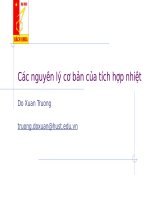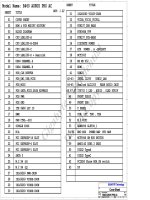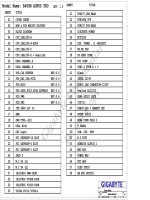a0058 apress pro sharepoint migration jun 201 morebook vn 1261
Bạn đang xem bản rút gọn của tài liệu. Xem và tải ngay bản đầy đủ của tài liệu tại đây (715.01 KB, 7 trang )
Download from Wow! eBook <www.wowebook.com>
For your convenience Apress has placed some of the front
matter material after the index. Please use the Bookmarks
and Contents at a Glance links to access them.
Pro SharePoint Migration
Moving from MOSS 2007 to SharePoint
Server 2010
Sahil Malik
Srini Sistla
Contents at a Glance
About the Authors.................................................................................................. ix
About the Technical Reviewer ................................................................................ x
Acknowledgments ................................................................................................. xi
Chapter 1: Migration Process .................................................................................1
Chapter 2: Migration for the IT Administrator ......................................................39
Chapter 3: Branding and Design Changes.............................................................75
Chapter 4: Migration for the Developer ..............................................................111
Appendix.............................................................................................................153
Index ...................................................................................................................207
iv
CHAPTER 1
Migration Process
SharePoint 2007 has been an incredibly successful product. Many organizations have reaped the
benefits. It is an undeniable conclusion that, sooner or later, you will be faced with the task of upgrading
to SharePoint 2010. What are the new capabilities of SharePoint 2010? What are the differences between
SharePoint 2007 and SharePoint 2010? What new benefits can you reap, and what unexpected
differences will bite you during your eventual upgrade? This book answers all of these questions and
more.
SharePoint 2010 is a complete package of powerful capabilities that you surely wouldn’t skip as a
product by itself. If you are a current user of or have implemented Microsoft Office SharePoint Server
(MOSS) 2007, we don’t need to explain to you the benefits of SharePoint at all. With SharePoint 2007’s
capabilities and the enhancements and new features in SharePoint 2010, migrating to the new platform
is certainly a good step. This chapter walks you through the different upgrade approaches, as well as
offering a high-level comparison of the two versions, including explaining new features, unsupported
models, and useful resources that you can benefit from during the overall migration process. In the
subsequent chapters, we will walk you through other important aspects, targeting topics that meet
needs and some key knowhow for IT analysts, designers, and developers.
Like MOSS 2007, SharePoint 2010 comes in three different flavors: Foundation (free), Standard, and
Enterprise. For a feature comparison and licensing overview, see Another edition of SharePoint is the online version known as
Office 365. We are not going to cover each the edition as well as Office 365 in this book. We’ll cover
enterprise-edition features, and that way, features of all editions will be covered. To begin with, we will
start with the comparison sheet between MOSS 2007 and SharePoint 2010.
Comparing MOSS 2007 and SharePoint 2010
Let’s begin with explaining the hardware requirements between the two versions. The biggest change in
SharePoint 2010 is in the infrastructure: a 64-bit operating system is now a mandate. Second, SQL Server
2005 Service Pack 3 (SP3) or higher (also running on 64-bits) is required. The rest of the RAM, hard disk,
and processor requirements can be scaled. Table 1-1 displays the minimum requirements on the server
infrastructure. Note that all servers in the farm where you install SharePoint 2010 need to abide by these
requirements, but the server on which SQL Server is installed may have its own additional server
requirements.
1
Acknowledgments
This is my second book with Apress, and I would like to thank Apress and Jonathan Hassell for giving me
this oppurtunity again. I would like to thank Sahil Malik for organizing the topics and their layout,
planning out the entire book, and internal review. I’d also like to thank Robert Garrett for providing deep
technical review and very valuable comments that significantly improved the quality of the book. I want
to also thank Brent Dubi and Douglas Pundick for managing and scheduling the timelines, content
editing, and suchlike. Finally, I am thankful to my family for their support and inspiration.
—Srini Sistla
First of all, I would like to thank my coauthor Srini Sistla. This book would not have been possible
without his hard work, sleepless nights, and tireless dedication. Second, I would like to thank Rob
Garrett, an author himself; having worked personally on projects with both Srini and Rob, I knew the
book was in the right hands. I would then like to thank Jon Hassell; his endless support and attention
allow us to focus on what we are good at. Finally, I would like to thank the rest of the Apress team,
including Brent and Doug for their discipline, attention to detail, and helping us stick to timelines. Most
of all, I would like to thank you, the reader, for your support.
—Sahil Malik
xi









